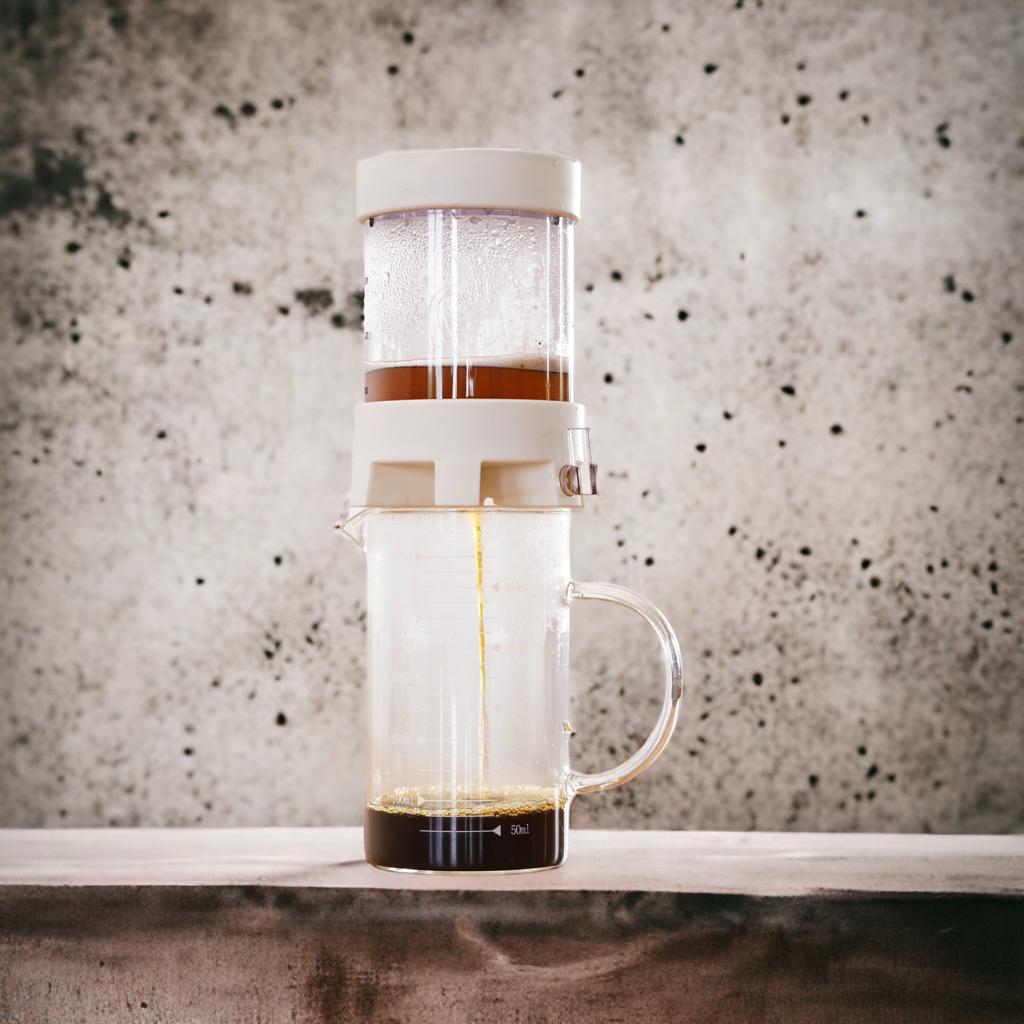Back when I published my book “The Physics of Filter Coffee“, I started drafting what I thought would be the ideal dripper for filter coffee. I wanted the dripper to be cylindrical, prevent any bypass of water around the bed of coffee, use the most possible open filter area under the coffee bed, and have a valve to control the flow of water through the coffee bed.
The reasons behind these choices were relatively simple: I wanted to have control on the flow rate to experiment with bloom time, allow for either normal pour-over methods or steeped immersions that could then slowly drip out by the action of gravity, and always make sure water flows as easily as possible through an equal amount of coffee particles without clogging the paper filter.

It turns out I was not the only one who had similar goals in mind, and other readers of my book at the NextLevel dripper company decided to build a new dripper called the Lvl-10 dripper. If you are a good observer, you might have noticed that both NextLevel and Tricolate had figured out something about no-bypass that I had not yet realized: it’s best to avoid high agitation in this scenario, so adding a dispersion screen is a good idea. In a V60, the agitation is important to get a good extraction especially at the bottom tip of the dose where less water passes through, but in a no-bypass dripper, not only there is no such region of the coffee bed that is more isolated from flow, but the total paper filter surface is also smaller, meaning it can clog more easily if too much agitation is applied.


I was super excited when I saw the Lvl-10 dripper, because it was very close to what I wanted to achieve, and as I expected, it performed very well in terms of extraction quality. The only differences with the design I had envisioned was the absence of a valve, and the diameter which I found was optimal for doses a bit larger than I brew at home – my personal preference for Lvl-10 is to use doses of 25-38 grams of coffee to get a relatively thick bed. Since they were already so close to what I wanted and they had the skills to actually put out a product, I decided to contact the NextLevel team and ask them if they were willing to create a new dripper with a slightly narrower diameter and a valve. Fortunately, it turns out the team at NextLevel are super nice and, on top of it, they were willing to commit the significant expenses that building prototypes and a new production mold involved.
After years of development, I’m super happy to report that the dripper I dreamed of for so long is finally out ! We decided to call it the Pulsar dripper, as a nod to my daytime job, and the idea of being able to “pulse” the flow of water through the coffee bed (although I don’t turn the flow on and off several times in my current favorite recipes).

Today I’d like to share my favorite recipe with the dripper, but I am sure many more recipes will eventually come out, which I can’t wait to read about.
The Steeped-Bloom Percolation
This recipe is my daily driver, and I find that it tends to highlight the sweetness, jammy, and juicy notes of a coffee.
- Weigh 20 to 30 grams of coffee. I personally like to grind a bit coarser than I do for V60 with a 20 grams dose; I use about 800 microns average particle size by eye with Pulsar, about 600-700 microns for V60. Using grind sizes of 600 microns can also taste nice, but the profile is different, so I would encourage you to play a bit with your exact grind size. If you use a dose of up to 30 grams, I’d encourage you to try out grind sizes almost as coarse as what you would use for a large batch brewer.
- Close the valve of the Pulsar base, and pour a bit of water until the water level is slightly above the top of the ridges.
- Place a dry paper filter on the pre-filled Pulsar base, and open the valve above the sink. The water will start draining and the filter will land on the ridges – you can then close the valve. This allows to entrap as little air as possible below the filter.
- Put the barrel on, and place the dry coffee in the dripper. Shake or use a WDT tool to level the coffee bed, and put the dispersion cap on (the part that acts like a shower screen), and tare your scale.
- With the valve open, start a timer and pour about 3x your weight of coffee in water (if you are using a 20 grams dose, pour 60 grams of water at this stage). Once the water starts dripping, close the valve gently, making sure your dripper does not tip over (valves are a bit stiffer for the first dozen brews). I noticed that the bloom is much more efficient if you let the water drip just a bit; this allows the air entrapped between the coffee particles to be displaced more easily by the incoming water.
- Once you poured the bloom water, take the dripper by the base (never by the walls) and swirl gently. You can also use the “Wet Weiss Distribution Technique“, but be mindful that the more aggressive you are, the slower the brew will get because the filter will tend to clog a bit more.
- If you use a gooseneck kettle, I recommend pouring relatively fast and in circular patterns to avoid digging holes in your coffee bed. Non-gooseneck kettles work just fine with Pulsar. I like to use 99 degrees Celsius water; not quite boiling to avoid the kettle stream becoming unstable; but still hot because the dispersion cap will cause the water stream to loose a few degrees (the droplets have a lot more surface area than a regular kettle stream), and I tend to drink roasts that are roasted quite light. if you like roasts more developed than say, Prodigal or Regalia, I recommend trying slightly cooler temperatures too, to determine what you prefer.
- Once your timer reaches 1 minute, open the valve and start pouring water again, in small pulses, trying to maintain a slurry that is always about 1 cm high above the coffee bed. You want to always keep a bit of water to avoid losing too much temperature, but using a slurry not much taller than 1 cm will keep astringency very low.
- Keep pouring in pulses until you reach a total coffee to water weight ratio of 1:17. You can also brew with a 1:16 ratio if you prefer stronger concentrations; you will not sacrifice as much total extraction as you would on typical drippers with Pulsar, because a lot more of the extraction happens earlier in Pulsar due to the no-bypass flat bed.
- You can also experiment with shorter or longer blooms; blooms as short as 15 seconds can achieve good saturation of the coffee bed if they are done well. Shorter blooms will yield a taste profile closer to V60, lower on sweetness, but higher in perceived acidity, tending more towards a tea-like beverage. Longer blooms will be sweeter, deeper, but if you go too far you can also start drawing some weird and off-putting flavors depending on the coffee (especially darker roasts). I’ll say a bit more on that in a future post.
- I aim for a total brew time between 3:30 and 4:30. I used to grind a bit finer and aim for 5-6 minutes total brew times, which tastes much better than what you would get with such brew times on a V60, but after lots of comparison brews, I tend to prefer the liveliness of coarser grinds a lot more. This is not too surprising given that well-prepared batch brews are often my favorite extraction profiles !
When cleaning the Pulsar, I recommend taking the barrels and the dispersion cap off together, flipping them and placing them on the counter (so the cleaner dispersion cap touches the counter), then flip the base over your bin while holding the valve such that the valve opens while you flip it; this will help prevent suction and allow the paper filter and coffee bed to fall in. If the paper filter doesn’t fall in, pinch it. Then rinse everything in the faucet, while making sure to wipe the inside of the barrel especially near the bottom as it tends to get coated with coffee oils. The NextLevel team also told me the dripper is dishwasher safe ! However, be careful because some dishwasher soaps can leave a bad coating that can affect your brew.
I have been enjoying recipes similar to this one for more than a year now, so I am all the more excited for you all to finally be able to try it ! Please let me know how you enjoy it.
Disclaimer: I receive royalties on the sales of Pulsar drippers because of my involvement in its design, but no benefits from the sales of other NextLevel items such as the Lvl-10.

